Homeschool Scheduling is simply the process of creating a plan for when homeschool education will occur.
These plans indicate time frames for studying and are often used to guide which subjects will be taught. Whether that be which days of the year homeschooling will occur or which hours will be dedicated to schooling on a given day.
Homeschool schedules are typically made by parents who are homeschooling their children, to outline their goals for what their kids will learn and when.
These schedules are more helpful as a guide than a rigid routine. Homeschooling does not often go exactly as planned, and every day is different. Still, having a general overview of what will be accomplished can ensure that your child’s education progresses appropriately.
Many homeschooling parents attended a traditional school as a child, and therefore are not used to making decisions about when or how education will occur. Making schedules is especially imperative in these cases, as the newfound freedom can be overwhelming.
Homeschool schedules can be broadly categorized as daily, weekly, or yearly schedules. Many parents will choose to make a schedule for each of these categories. Yearly schedules are for laying out instructional versus break days, while weekly schedules are often used to assign specific subjects to days of the week. Daily schedules vary in detail, but at the very least, plan out chunks of time for learning to occur.
Free Templates
Homeschool schedule templates provide sample schedules that can be easily customized to your needs. Instead of starting from scratch, you can use templates to follow a pre-made outline and simply insert the relevant personal information in the black spaces. You can browse a variety of layouts according to your preferences. Some are more structured or specific than others.
You can also find templates with extra features like color-coding. Using these templates saves you time and provides you with a readable and neatly designed outlook of your day, week, or year.
Following are some free downloadable templates for you:
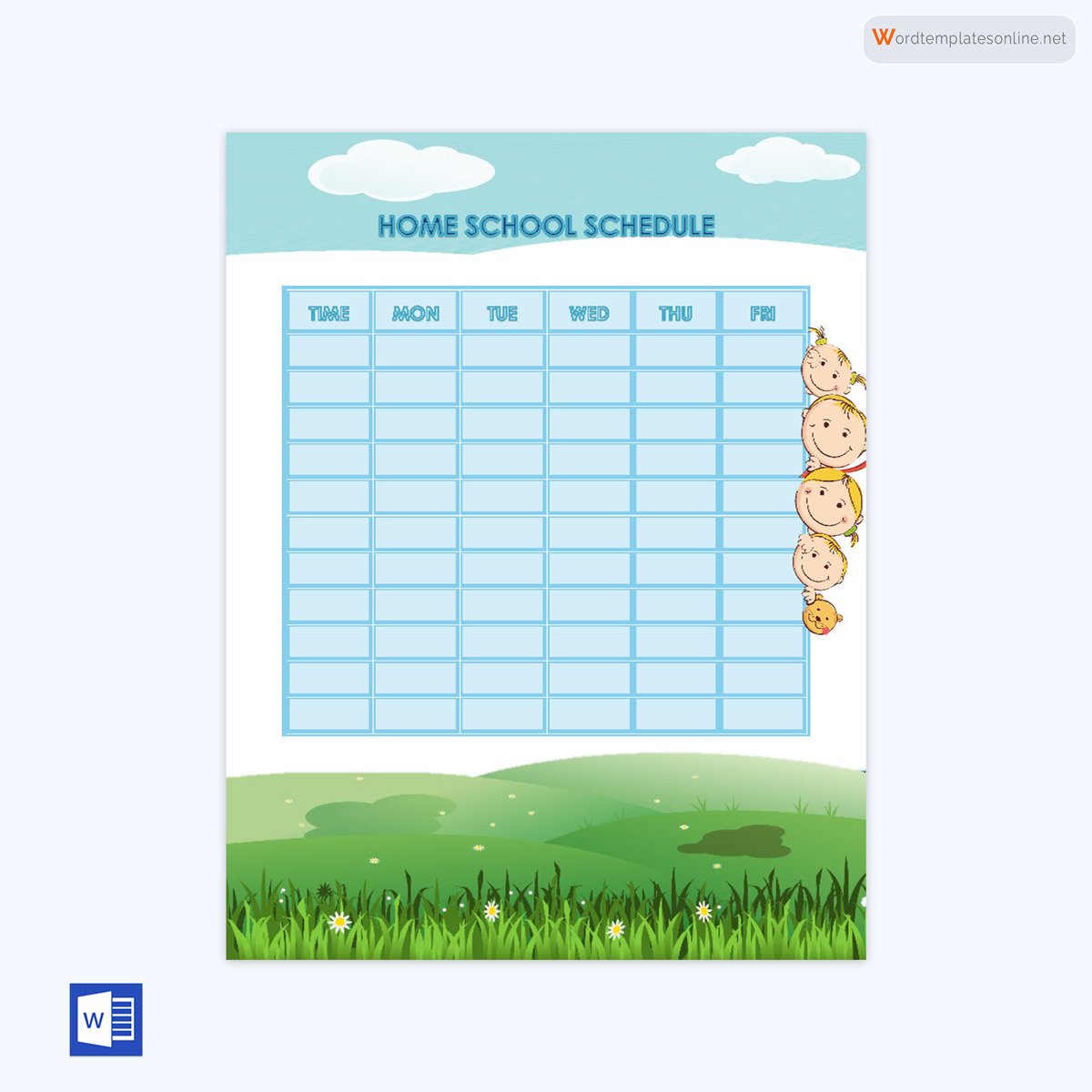

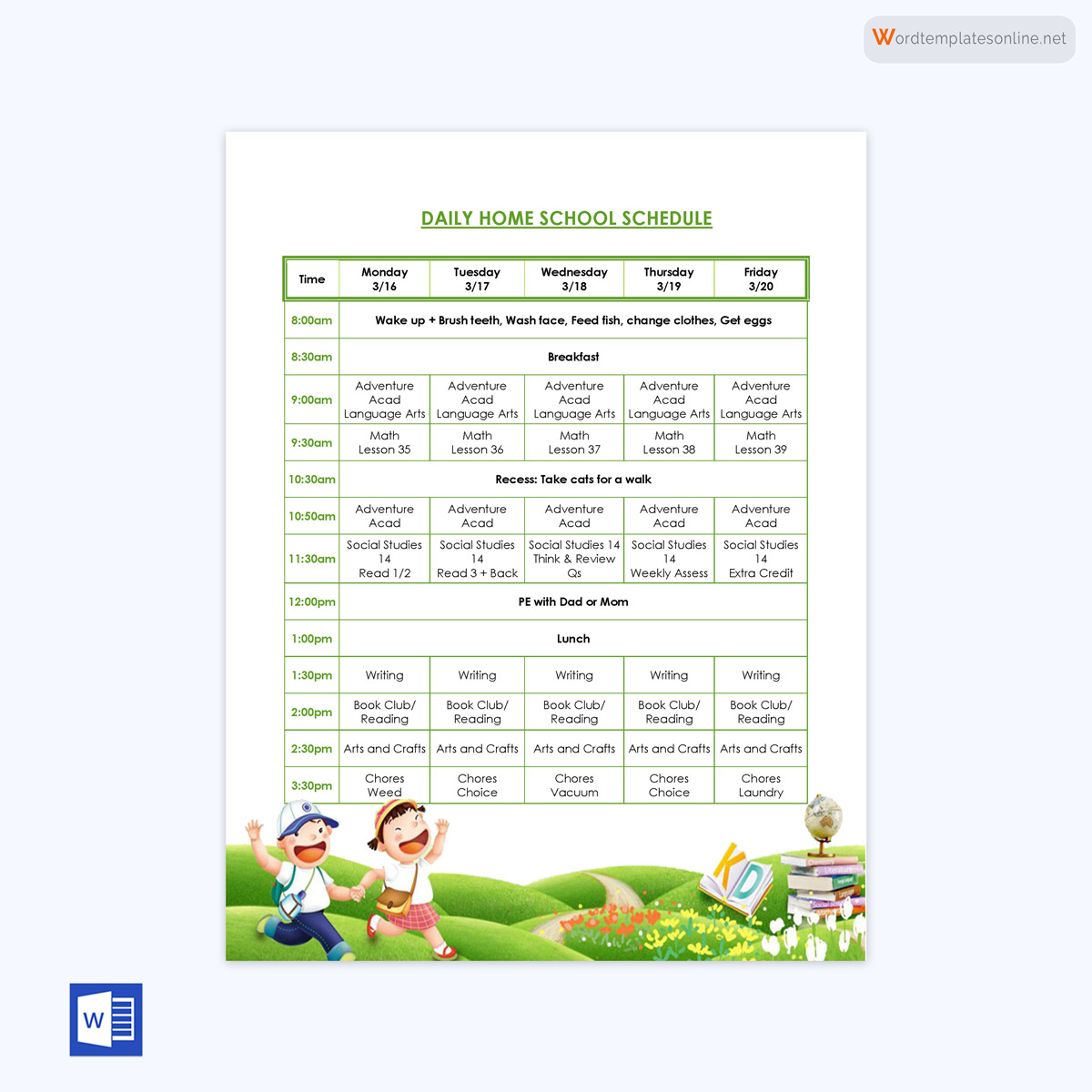

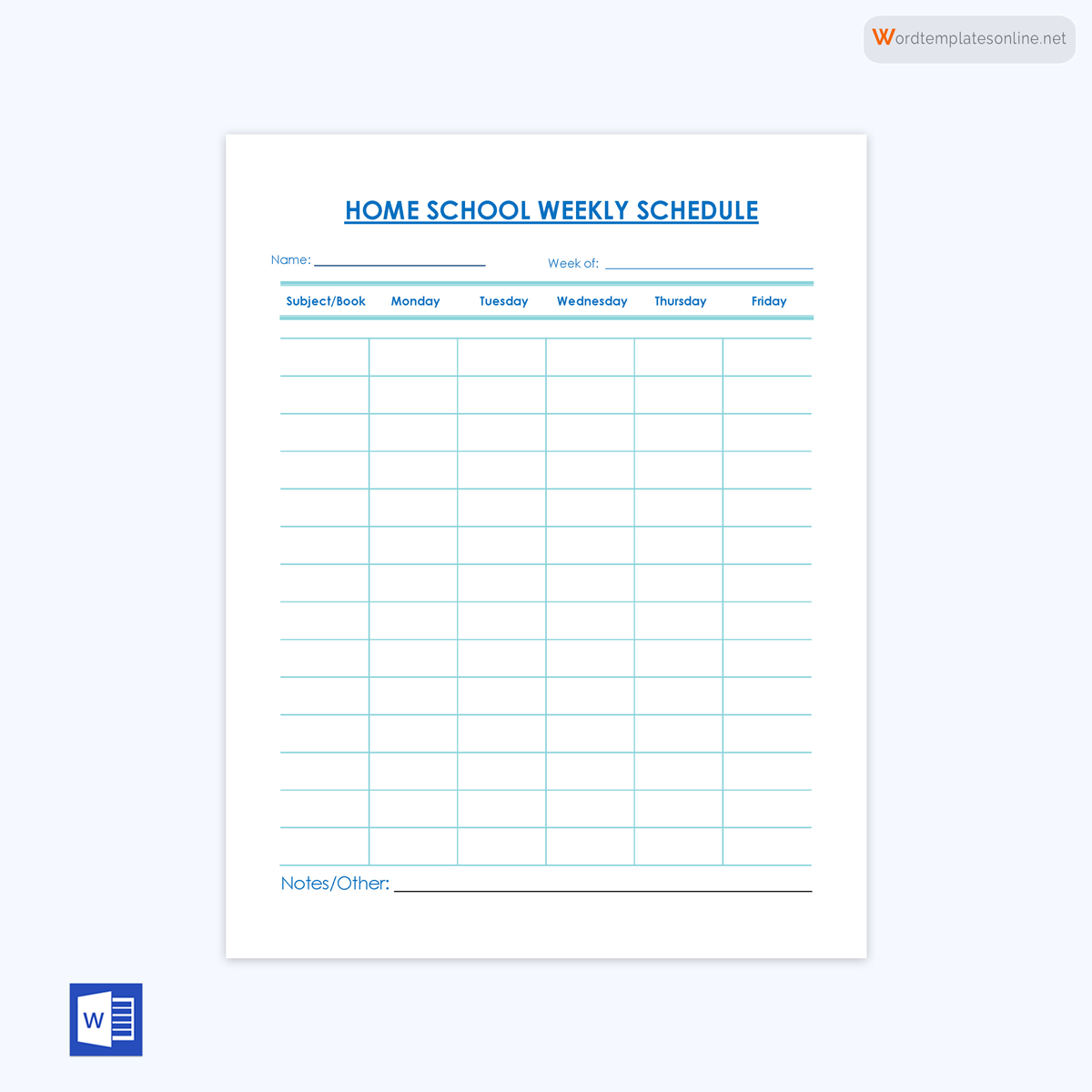

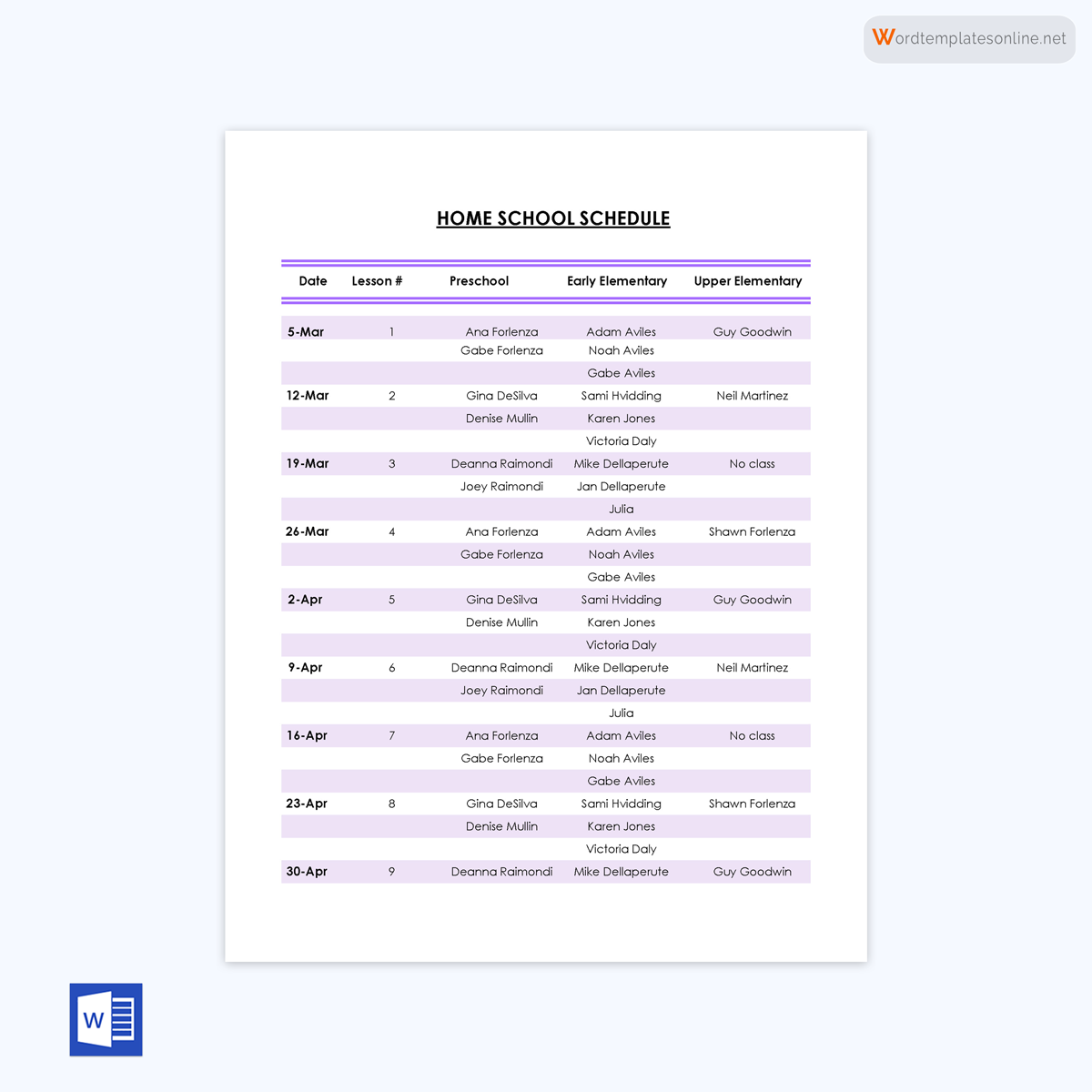

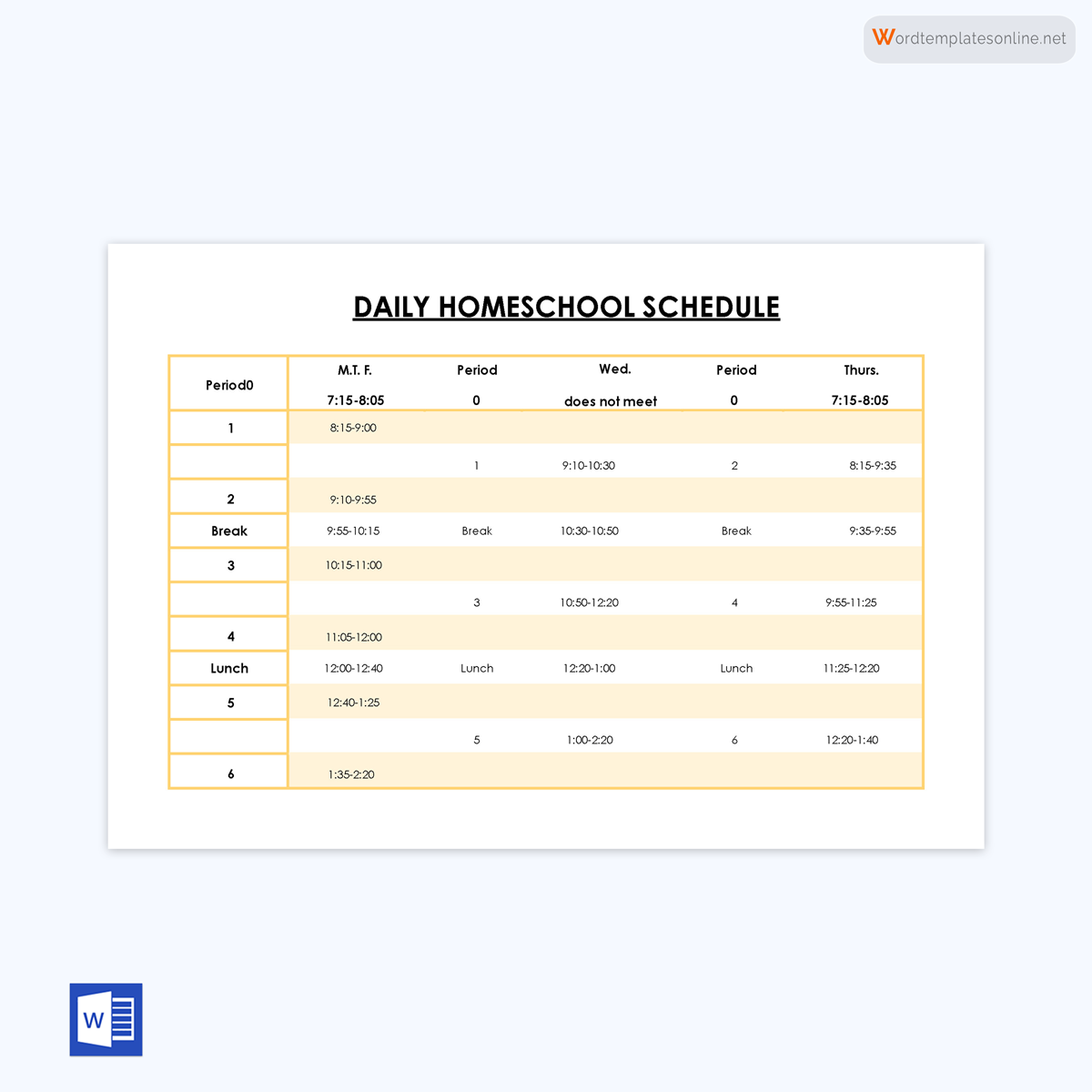
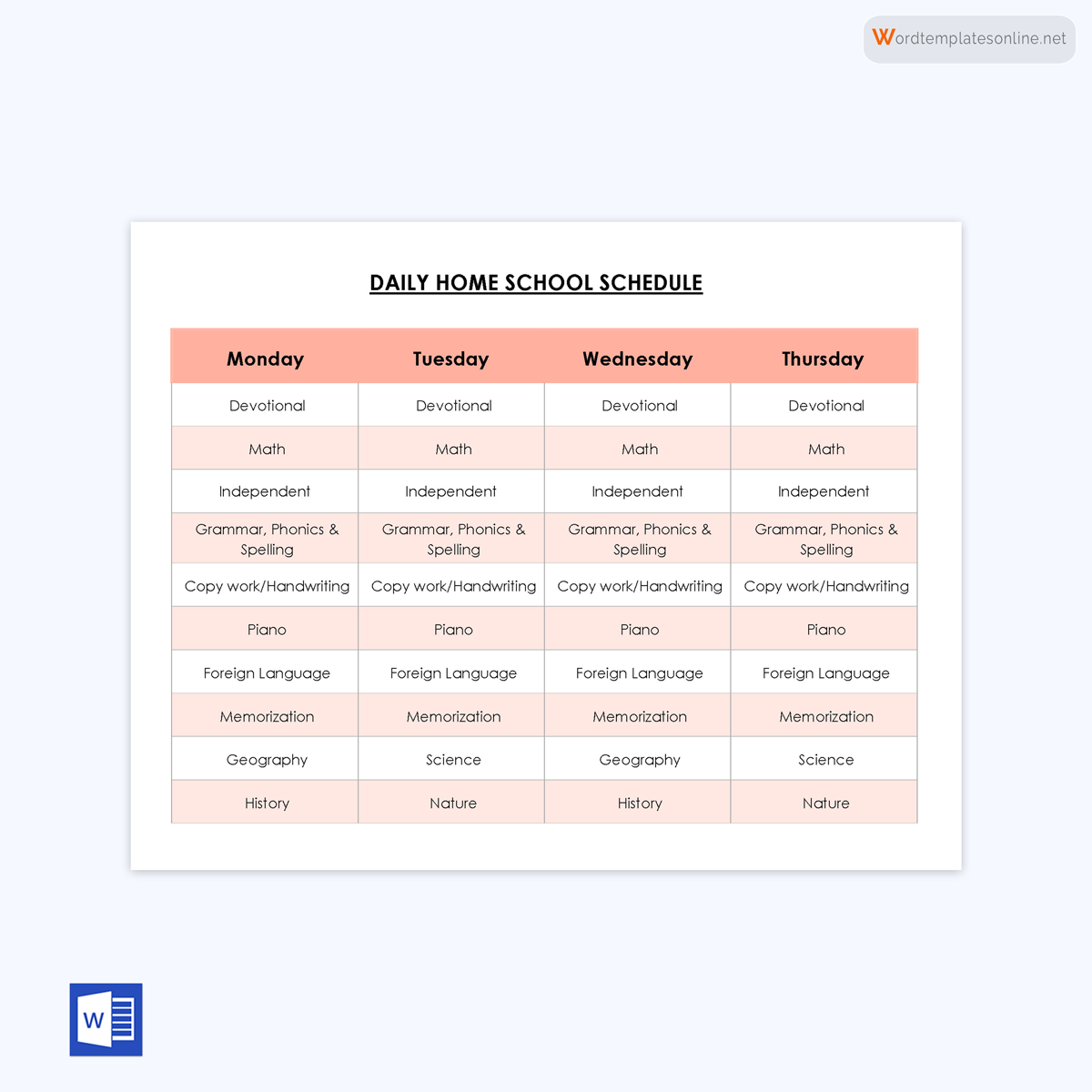

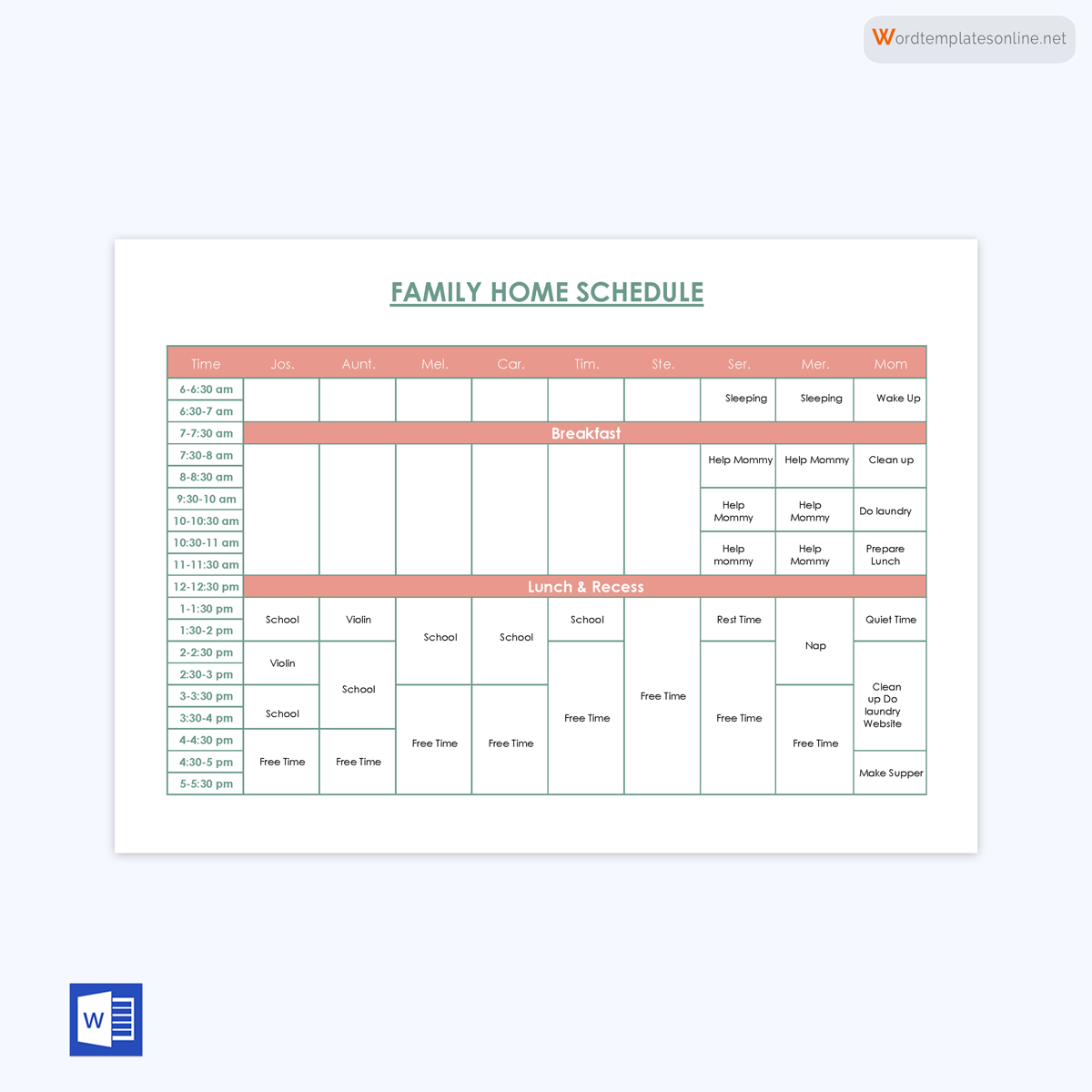

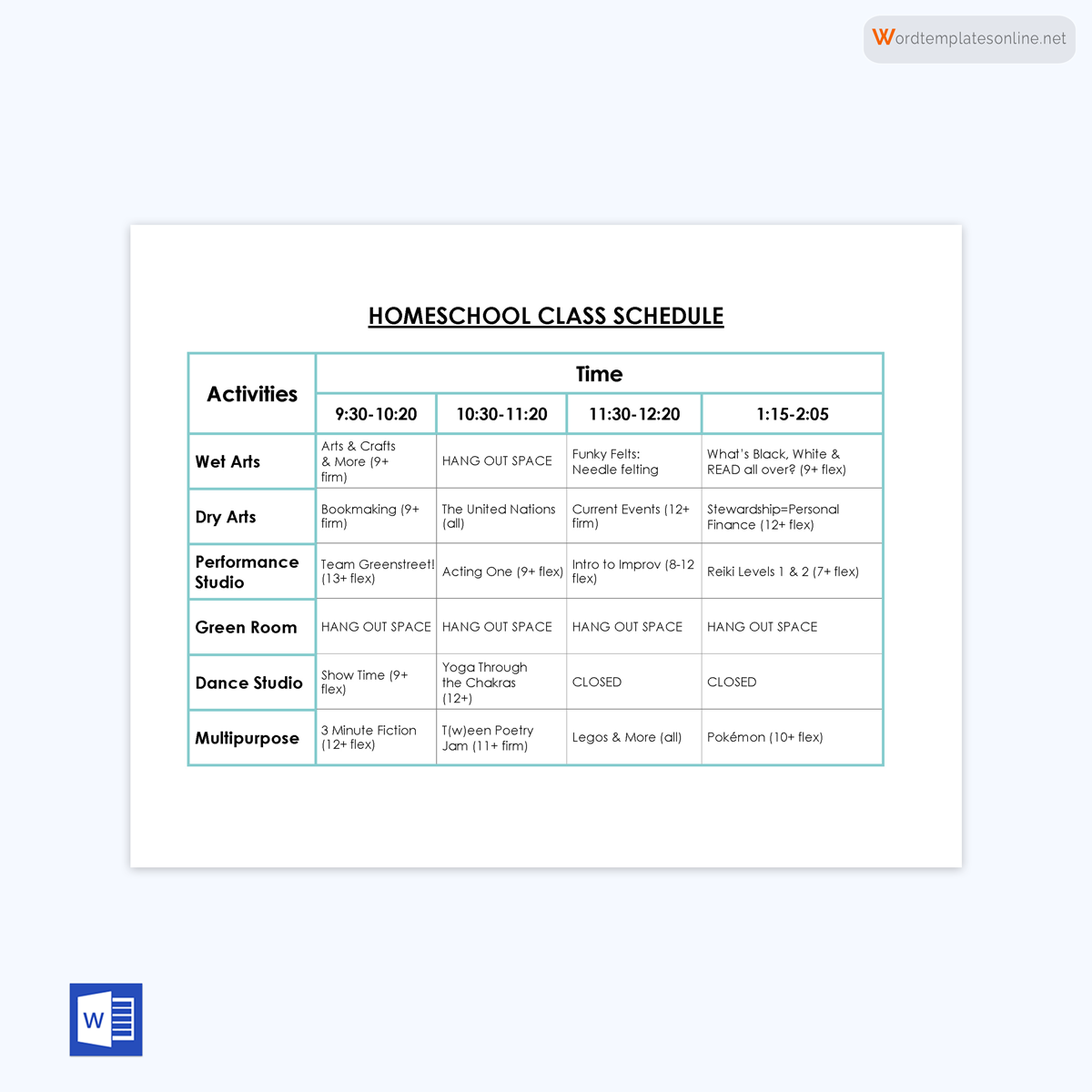
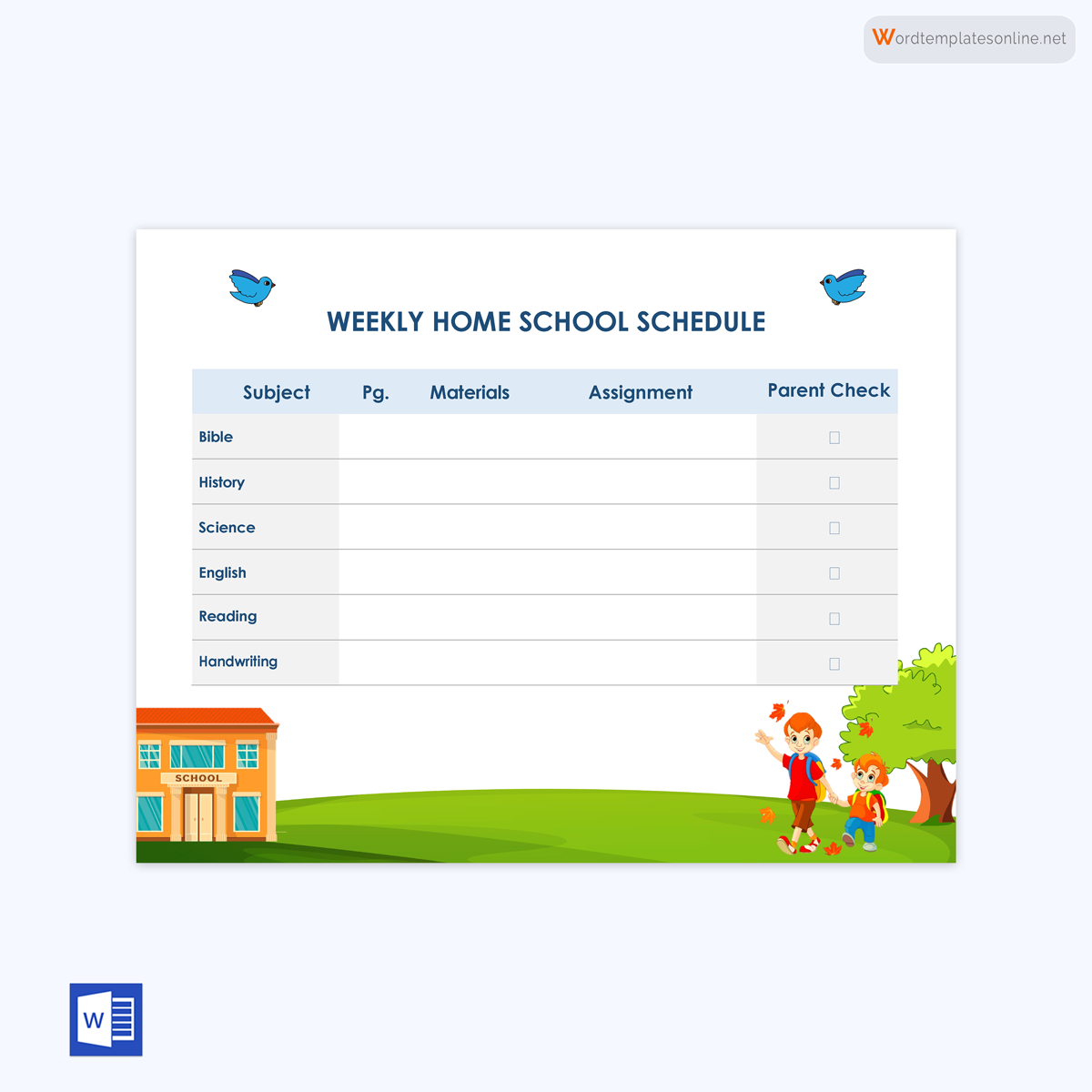
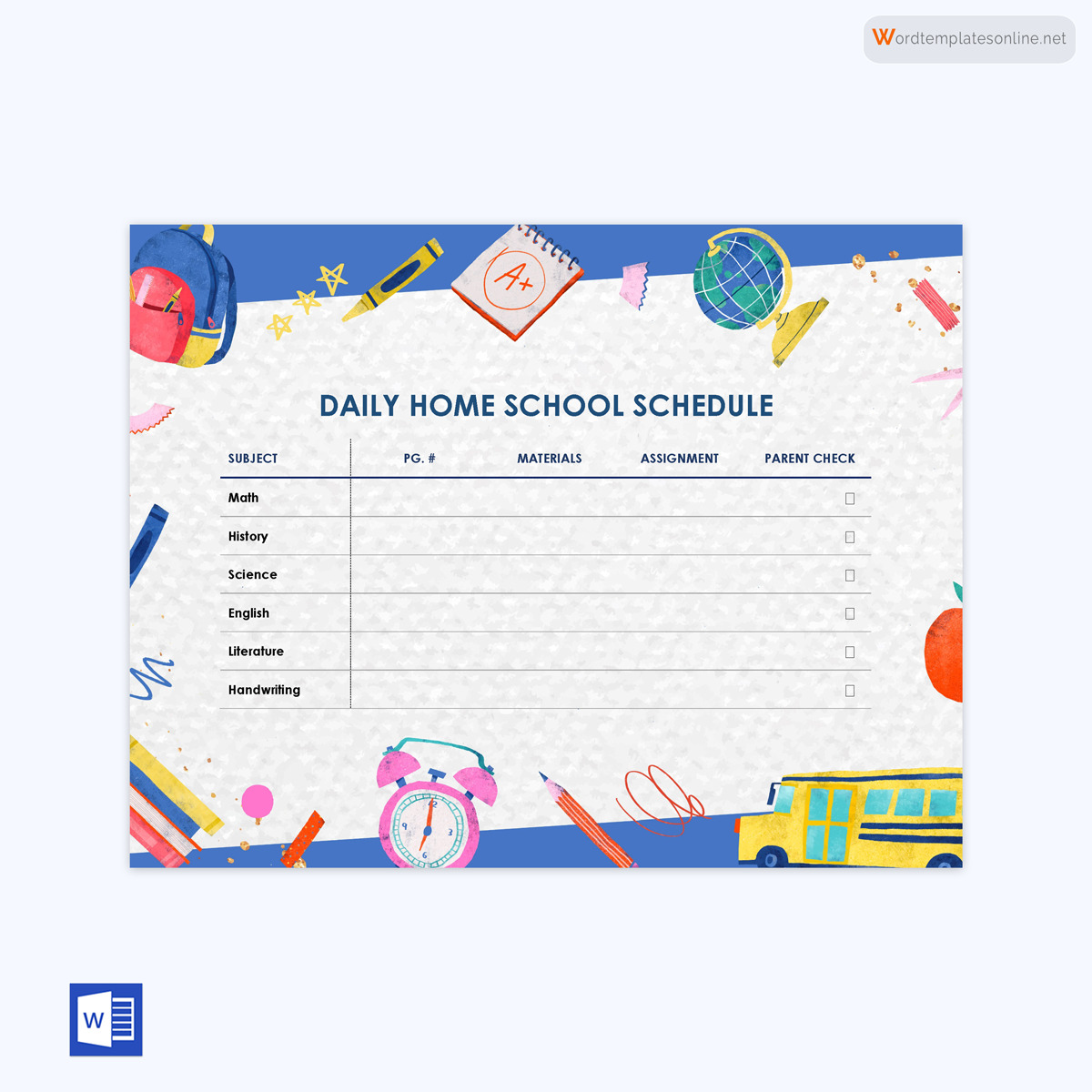
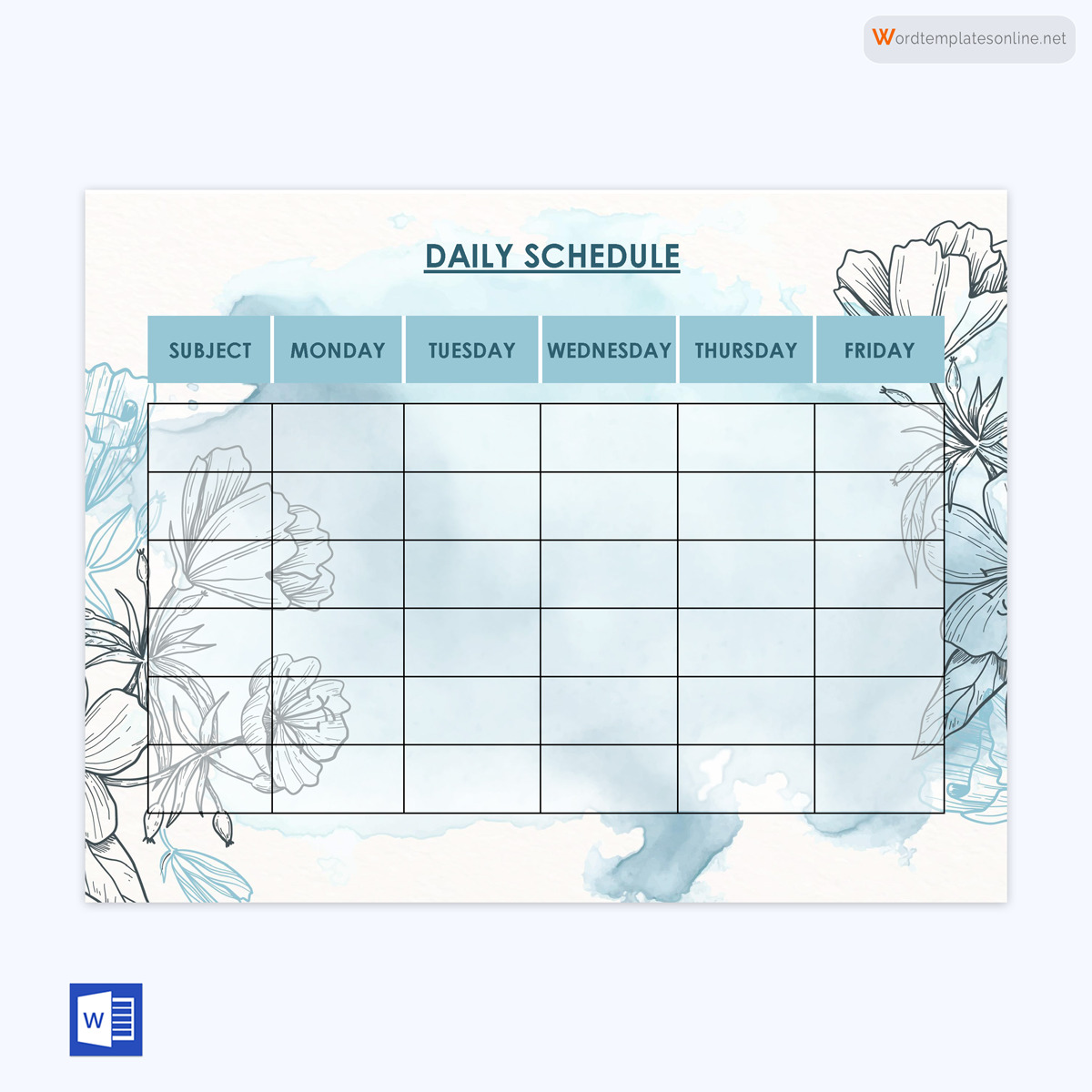
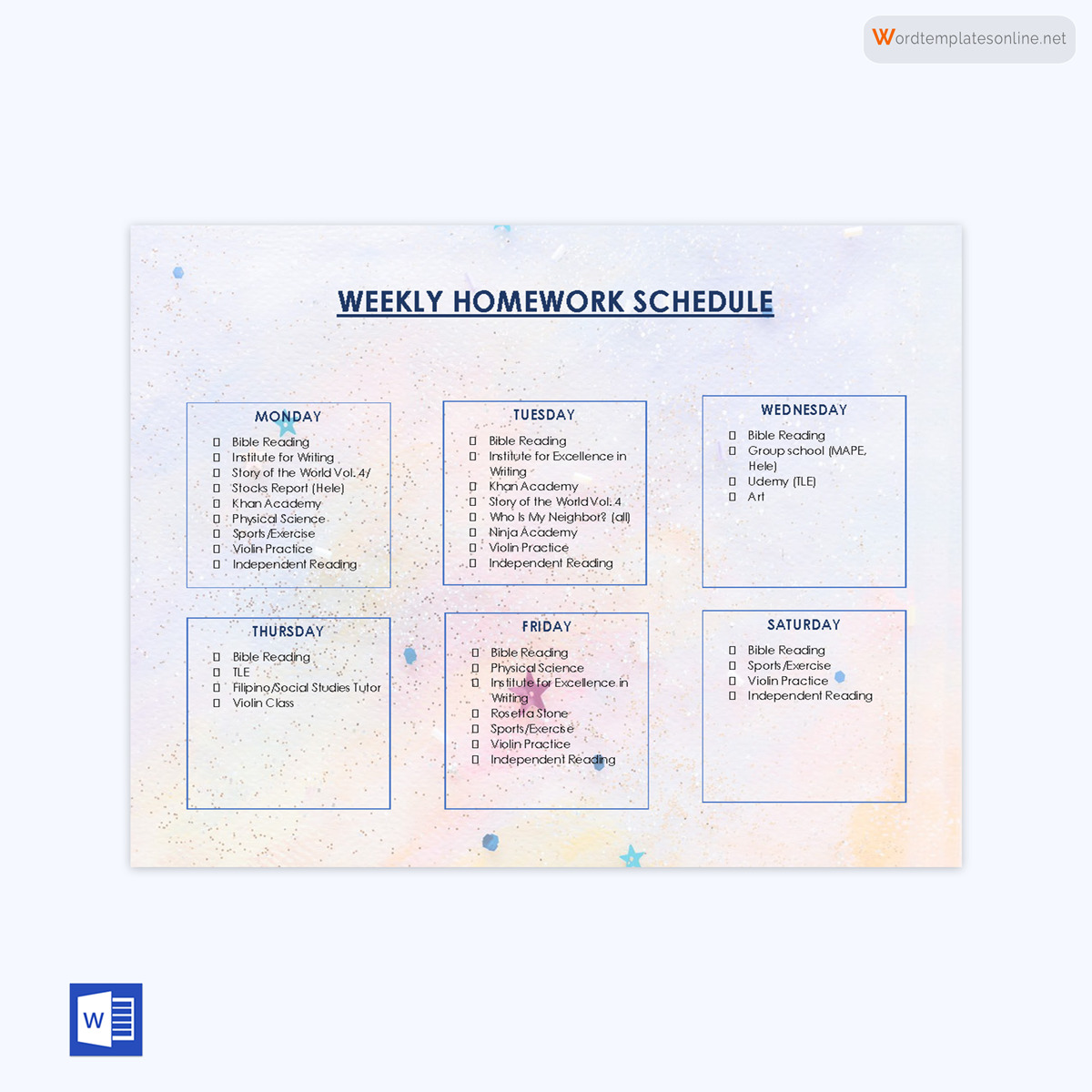
Different Approaches to Homeschool Scheduling
There’s not just one way to schedule homeschooling. In fact, it’s most effective to have multiple schedules for different units of time.
Read on for explanations of some of the most common strategies used to plan at-home education:
Yearly schedules
Yearly schedules resemble academic calendars in the way that they dictate what days are school days and what days are breaks. They are essential because without using them, you risk breaking your state’s laws.
In some states, there is a minimum number of homeschool days required every year. Be sure that you are knowledgeable about the specific requirements in your state and that your yearly plan accommodates this.
Weekly schedules
Weekly schedules plan out the days of the week where homeschooling will occur and specify to varying degrees which subjects will be tackled each day. In traditional schools, students follow a Monday through Friday schedule and may study the same subjects every day depending on their grade level.
However, as a homeschooler, you can arrange the school week any way you like, so don’t hesitate to think beyond the typical school structure.
Four-day week schedule
The four-day week schedule is perfect for those who want a real-life experience to accompany their kid’s education. This prioritizes hands-on learning by limiting classroom-style instruction to Monday through Thursday to leave Fridays free for beyond the classroom experience, preparing for the days ahead, or just tackling to-do lists. A major advantage of the four-week schedule is that it is easy to find a curriculum geared towards this structure.
Traditional five-day week schedule
The five-day week typically aligns with the standard mode of Monday through Friday school. One advantage of this schedule is that many curricula are based around this structure, so you could follow them easily without making changes.
A five-day plan also lends itself to a consistent schedule, which is great for planners. However, many parents choose to homeschool because traditional school times don’t work for their families, so this approach is not for everyone.
Block schedule
Block schedules are also used in traditional schools and refer to a weekly format in which subjects are taught in larger chunks on 2-3 days a week instead of in small chunks every day. This could mean students learn biology for two hours on Tuesdays and Thursdays instead of one hour Monday through Thursday.
The advantage of this strategy is that children do not have to be overwhelmed with constantly switching gears to multiple subjects.
Loop schedule
Loop schedules consist solely of a list of activities to do regularly. Instead of assigning subjects to each day, you cycle through the list in order. Therefore, they easily accommodate missed days or activities that take longer or shorter than anticipated. When subjects are missed, the loop will continue the next day.
Daily schedules
Daily schedules typically involve the most in-depth planning. For some families, this looks like allocating a subject for every hour of instruction for every day of the week. Other families have more of a routine than a strict schedule. They may work on the same subjects in the same order, but they do not fall into specific time intervals.
Most importantly, daily schedules must align with the minimum daily homeschooling hours set by your state.
One-subject-a-day schedule
The one-subject-a-day schedule assigns one subject to each day of the week. The main advantage is allowing students to hone in one subject and ensuring that there is time to cover in-depth information.
A common approach is to assign the four major subjects (math, English, science, and social studies) in your preferred order on Monday, Tuesday, Wednesday, and Thursday. Then, leave Friday up to various electives.
One-subject-a-day-plus schedule
The one-subject-a-day-plus schedule is perfect if you want your kids to deep dive into a different subject each day, but you also have activities, skills, or topics you want to work with daily.
The only difference between this schedule and the one-subject-a-day schedule is that you reserve extra time for daily practices. These practices are specific to your child’s needs, but common choices are math problems, handwriting sheets, or memory practice.
Co-op-driven schedule
If your child participates in an academic co-op that meets regularly, it will be necessary to plan accordingly. Some co-ops assign homework, so in this case, your schedule should include regular blocks of time for completing any outside work. The main goal of co-op-driven schedules is to spread co-op assignments and subjects or academic interests not covered in the co-op throughout the week when the group meetings are not occurring.
University model co-op schedule
The university model schedule refers to a specific type of co-op where students meet for Monday/Wednesday classes or Tuesday/Thursday classes. Students, therefore, attend class 2-4 times a week. The major advantage of these co-ops is that it allows students to form a relationship with professionals or experts in the subjects they’re studying.
Shift-work schedule
Shift-work schedules are appropriate for families with a parent who works an irregular schedule.
EXAMPLE
If one parent works shifts and the other handles the homeschooling, the school may be scheduled during the shifts. However, if the shift-working parent participates in the schooling, the schedule may be geared towards when neither parent is working.
Extra-curricular and class-driven schedule
The extra-curricular and class-driven schedule is best when children are committed to a variety of activities outside school. Lesson times are then planned within the gaps of times where you or your children do not need to be in a specific place at a specific time.
Since homeschooling is flexible, there is no reason to fear that your children will have to sacrifice their academics to participate in other activities. These activities simply need to be accommodated in the schedule.
What-we-need-to-do & what-we-want-to-do schedule
Not every family is suited to a detailed or specific homeschooling schedule. If your homeschooling style is more project-based or if you’re an unschooler; you may benefit from a more spontaneous perspective of homeschooling such as the what-we-need-to-do & wat-we-want-to-do approach. Your plan may be to take each day as it comes and follow where your child’s interests take you.
Alternating home/out schedule
If your child runs errands or has daytime activities like volunteering, the alternating home/out schedule may be ideal. In this schedule, the homeschooling plan revolves around a pattern of days spent in the home and days spent out of it.
EXAMPLE
Your child may spend one day in a dance studio and the next reading at home. This works perfectly for rural families who cannot make the drive out to activities daily.
Creating a Homeschool Schedule
Choosing the homeschooling approach most suitable for your family is only the first step.
Read below for practical advice on keeping the process of creating your actual schedule simple and effective:
Create a routine
While you will be physically creating a schedule, it can be helpful to think of it as more of a routine. It is unlikely that your homeschooling days will go exactly as you planned 100% of the time. Narrow time slots can be unrealistic and create frustration. One effective approach is creating grace periods.
EXAMPLE
Instead of scheduling reading from 9 am to 10 am, you can plan to start reading sometime between 9 and 9:30 and end between 10 to 10:30. Even then, you may get thrown off course and have to go with the flow.
Schedule in the blocks of time
It can be helpful to focus more on planning when you will do schoolwork rather than exactly what will be done every hour. Each day you may have a certain number of blocks, or chunks of time, within your day that homeschooling occurs.
EXAMPLE
Homeschooling might occur for two hours between breakfast and lunch and two hours between breakfast and dinner.
A routine of when you work is often easier than a routine that dictates what you work on. In addition, the load of work for each subject likely varies day today. Therefore, rotating heavy and light subjects within chunks can be more effective than prescribing a rigid order of subjects.
Leave a margin
A four-hour block dedicated to homeschooling will likely not amount to four hours of schoolwork. Even within a span of just a few hours, you can expect life to get in the way. Whether it’s bathroom breaks, hungry children, pets issues, or tears, there will always be spontaneous issues that you can’t anticipate when making a schedule. If you want your child to match the hours of schoolwork you’ve set for them, it’s best to add a time buffer so that unpredictable events don’t throw their school day off course.
Schedule the siblings
If you have multiple children of varying ages, chances are they need you for different tasks at different times. When drafting a homeschool schedule for one child, consider what their siblings might expect from you at that time.
EXAMPLE
If you are nursing and typically feed your baby at 9 am, plan to give other kids independent work at that time. If you have a toddler with grown siblings, the older children can take turns entertaining the toddler and working with you one-on-one.
Also, keep in mind that preschool-age kids typically need more of your attention, so try not to work solely with your older kids for hours at a time. Naptime is a perfect window to work peacefully with your eldest.
Don’t do every subject daily
If you break down broader categories like science and language arts, there are dozens of subjects to learn in school. Trying to cover everything every single day is an impossible task. Depending on your child’s age and what subjects they’re pursuing, you may not hit each area of study even on a weekly basis. It’s better to think of approaching each subject regularly rather than daily. This is made simple by choosing a block or loop schedule.
Schedule priorities around constants
There may be skills, like reading aloud, that you want your child to practice every day. An easy way to keep up with this is to schedule your priorities on the hooks of your day that are already occurring. The most common hook is meal time. So, you may have your child read right before lunch every day. Even if lunch occurs at different times throughout the week, as long as your child does not skip lunch, they will also not skip reading.
Follow your natural inclinations
You know your family better than your homeschooling neighbor does. Therefore, it’s natural for your schedule to look different than that of others you know.
One of the biggest perks of homeschooling is its flexibility, so don’t be afraid to take advantage of it. If you have one early riser and one-night owl, you can accordingly schedule the beginning and end of their school day.
Draft a plan
Schedules are working documents that are adapted as needed. Don’t expect your first plan to be final. Consider it a draft that may require many changes. You won’t know how effective your plan is until you take it on a test drive. It may even take several weeks or months for necessary improvements to be made clear. It’s best to write in pencil at the start so you can easily erase your writing as you work things out.
As mentioned above, it’s best to start with blocks when making your schedule. It’s helpful to give the names of the blocks based on what your children will learn or when they will occur (i.e. lunch block, science block). You may then go on to fill the blocks with subjects.
Keep in mind the breaks in the day and what subjects would be better at which points. If one block occurs while you are making dinner, it should include subjects with independent work. Remember that within the blocks, it may not make sense for the subjects to follow the same order every day and that one subject may take more time one day than it did on the day before. Still, it can be helpful to know what subjects you plan to approach even if you are unsure how long each will take.
Free Downloads


Tips to Create a Strong Homeschool Schedule
The strongest schedule takes all of life into consideration. Each day of the week may bring different errands, activities, and work commitments that must be accommodated within the schedule. Have a list of other weekly responsibilities (grocery shopping, laundry, etc.) with you when drafting a schedule to ensure time is made for all aspects of your family’s life.
Additionally, don’t just make time for what you have to do. A good homeschooling schedule leaves room for what you want to do as well. Both parent and child need time to recharge and pursue non-academic interests. Overscheduling leaves both parties burnt out and precludes a positive learning environment.
Strong schedules also have a visual component that helps each family member anticipate events of any given week and keep everyone on the same page. It’s great to print a weekly schedule to stick on the fridge where each person can see it. Along with weekly schedules, a yearly schedule is necessary to map out the correct number of required school days.
The best schedules are flexible and adapted to each family. It’s ok to not get it right on your first day. Trial and error will help you find the right match for your family’s needs. Even then, a schedule that works one year might not work the rest.
Job changes and growing children can necessitate changes in your plan.
EXAMPLE
Students at higher grade levels will need more hours to complete their daily work than first graders.
Finally, it’s highly beneficial to accompany your schedule with a checklist. Since your school days will not always go as anticipated, it is helpful to record what was completed and what you need to revisit.
Factors Affecting the Homeschool Plan
It is unlikely that the first few weeks of your homeschool plan will pass without challenge. However, it is possible to anticipate where your schedule may be mismatched to your family’s lifestyle.
Here are some common factors that can cause delays in homeschooling:
Sleep needs
On a biological level, kids vary in their sleep needs. For instance, older children tend to need more sleep but get tired later at night. So observing your children’s natural energy levels and sleep patterns can help you plan their school day around when they will be well-rested and alert.
Work schedules
Shift workers tend to have irregular work weeks and may not even receive an advance schedule. If you are both a homeschooler and a shift worker, mapping out a consistent school schedule can be extremely difficult. In these cases, homeschooling plans may be adjusted every week.
Family needs
A lot can change within a family in a short amount of time. Significant events like a new baby or the death of a grandparent can take their toll on a once successful schedule. Changes in family demands indicate that a schooling plan should be revisited for temporary or permanent adjustments to keep school and family life blending comfortably.
Outside classes
Many homeschool students are also enrolled in co-ops or dual enrollment. As your children participate in different classes yearly or semester, you may need to adjust your blocks and starting time.
EXAMPLE
They may have an afternoon class one year and a morning class the next.
So flexibility, like always, is a must.
Final Thoughts
Home school scheduling is a must for keeping your children’s education on track. However, ideally, these schedules are used to outline general routines rather than nit-pick and micromanage. Be prepared to adjust your schedule in accordance with the changing family demands and growing kids. Most importantly, take advantage of the flexibility homeschooling brings to your family’s life. Choose the schedule that serves your family best, no matter how non-traditional it may be.




